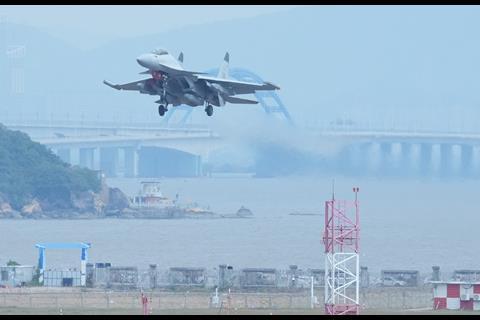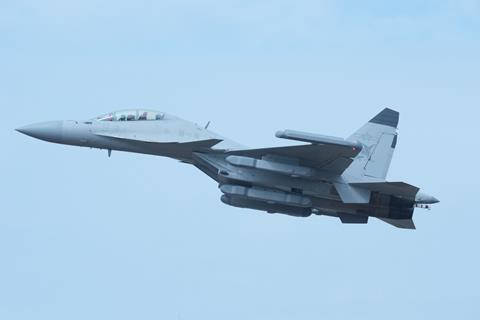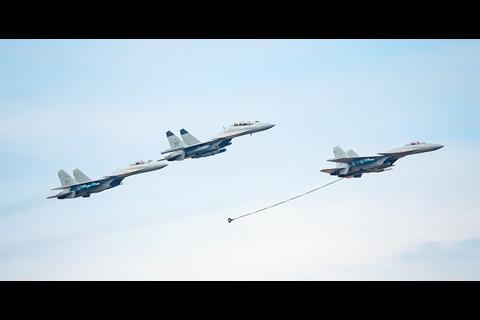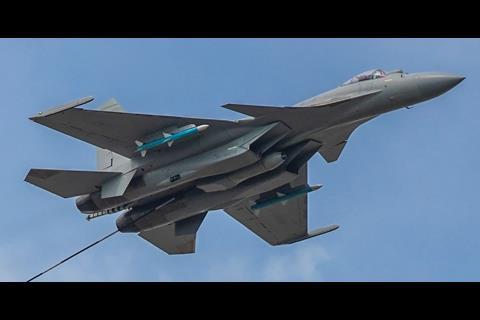The Shenyang J-15D electronic warfare (EW) jet and the China Aerospace Science and Technology Corporation (CASC) CH-7 unmanned air vehicle (UAV) have made their public debuts at the Zhuhai air show.
Clear images of the J-15D emerged on Chinese social media days before the show, which will run from 12-17 November in the coastal city of Zhuhai.
The J-15D is based on the J-15 naval fighter, itself derived from the Sukhoi Su-33. Developing an EW aircraft from a fighter has precedents, most notably the US Navy’s Boeing EA-18G Growler is based on the F/A-18F Super Hornet.
The jet features wingtip radar warning receiver pods that are likely to perform a similar function to the Northrop Grumman AN/AlQ-218s found on the EA-18G.
The aircraft also features four jamming pods, with two mounted under the wings and two under the intakes. The J-15D’s pods appear to lack electricity-generating ram air turbine found on the legacy US jamming pod, the ALQ-99, and the newer Raytheon Next Generation Jammer Mid Band – which flies on the EA-18G.
The J-15D in the images also lacks missiles. The EA-18G carries the Raytheon AIM-120 Advanced Medium Range Air-To-Air Missile for self-defence. The Growler can also prosecute radar sites with weapons such as the AGM-88 High-speed Anti-Radiation Missile and the Raytheon AGM-88E Advanced Anti-Radiation Guided Missile.
China’s air-launched anti-radiation missile is the YJ-91, which was developed from an earlier Russian system.
The debut of the J-15D at Zhuhai follows that of the J-15T. The J-15T features a catapult launch bar that will enable it to launch from China’s developmental aircraft carrier, CNS Fujian, using the vessel’s electromagnetic aircraft launch system (EMALS). Images from the show also show the J-15D flying with a pair of J-15Ts, one of which is equipped with a buddy air-to-air refuelling system.
Unlike its J-15T companions, the J-15D at Zhuhai lacks a launch bar, restricting it to operating form China’s two operational carriers, CNS Liaoning and CNS Shandong, which use a ski-jump to launch aircraft. Given the importance Beijing places on EW, however, the emergence of a J-15D with a catapult launch bar is all but inevitable, allowing the type to operate from China’s most capable aircraft carriers.
In combat, the J-15D could perform a similar role to the EA-18G by supressing enemy air defences and creating pathways for accompanying fighters.
A genuine CH-7 drone is on display for the first time at #AirshowChina2024, showcasing China’s advanced stealth technology. #SoaringDream (Video: Yang Sheng/GT) pic.twitter.com/RiR7TcHxg6
— Global Times (@globaltimesnews) November 10, 2024
Separately, Chinese state media reports that a “genuine CH-7” UAV is on display at the show. According to the commentary, the low-observable system is designed to operate relatively close to enemy radars, providing targeting data to other forces.
Though the CH-7 is shown with an array of bombs and missiles, its true value appears to be providing long-range targeting support for Chinese kill chains, allowing Chinese aircraft, ships, and ground forces to strike an adversary at long ranges.
The CH-7’s appearance the show follows footage on Chinese social media that shows what appears to be a prototype in yellow primer conducting taxi tests at an undesignated location, possibly as part of its flight test campaign.






























